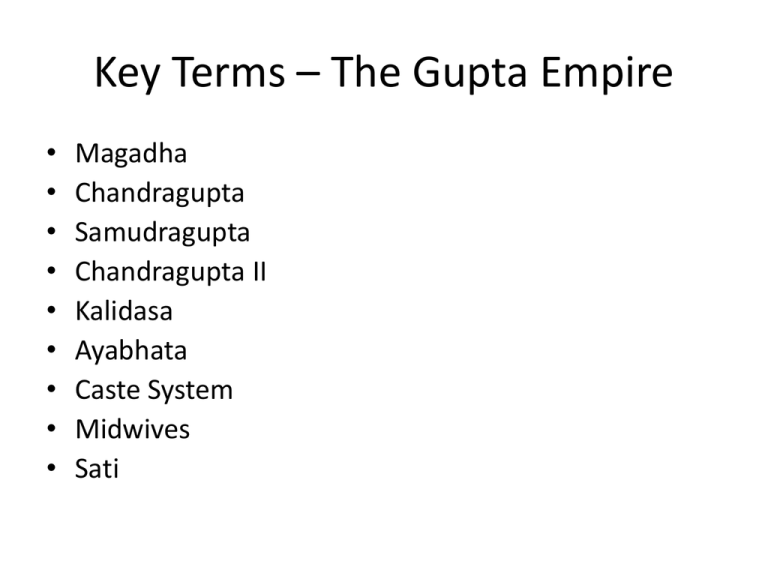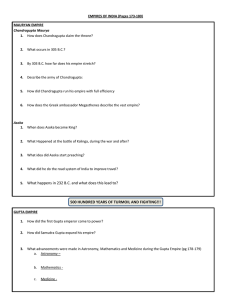The Gupta Empire
advertisement

Key Terms – The Gupta Empire • • • • • • • • • Magadha Chandragupta Samudragupta Chandragupta II Kalidasa Ayabhata Caste System Midwives Sati The Beginning of the Gupta Empire • 320 A.D. new ruler would take over the northeastern region of India. • Chandragupta ruler who managed to consolidate the previously divided northern territories of Magadha. • Chandragupta, through his efficient rule would be able to start a new dynasty known as the Gupta Dynasty which lasted from 320 -467 A.D. Samudragupta • Considering that the other parts of India were still divided into small parts, the second Gupta emperor would take up the task of reuniting them. • Samudragupta (330-375) would reconquer many of the independent kingdoms, would absorb the northwestern region of India extending as far down as the Deccan. Chandragupta II • Chandragupta II would acquire control of the Silk Road trade route entering India. • By defeating the Shakas (a group from the borders of China), he would be able to gain access to the Silk Road trade route which had previously been blocked. • Through his actions, he was able to enter into trade with the Middle East which improved the economy of the empire. Cultural Changes • Through their acquisitions, the Guptas were able to enjoy a period of great intellectual and cultural achievement. • Colleges, universities and libraries thrived and also maintained Sanskrit writings of the past. • Many masterpieces were created at this time which stood up against the writings of the west. Kalidasa • Kalidasa wrote plays in verse, mostly revolving around love, adventure, moral lessons, and beauty in nature. • The Mahabhrata and the Ramayana were completed during the period of 400-450. Changes in Science and Math • Invented the decimal system and the concept of zero (later considered arabic numerals). • Pi was calculated, which represents the relationship between the circumference of a circle and its diameter. • Ascertained that the earth was a sphere and the causes of lunar eclipses. Government Structure • Princes controlled the outer territories – Collected taxes and tribute from other territories – Usually had ties to the emperor through marriage alliances – Outlying areas were easily indirectly controlled through Hinduism religious leaders exercised powers over their societies. The Caste System • In the 1500’s B.C., around the same time as the Indus Valley cities sprang about, the Aryan tribes entered into India. • The Aryans introduced the caste system to India; broke the society into four major castes. • There were to be no interrelations between the castes since it was strictly forbidden. • Hindu missionaries would spread the faith, the ideas behind the castes, and the Sanskrit language to other areas in Southeast Asia. Women in India • Wealthier families usually educated their daughters, giving them the ability to create works in literature, though many would not ever become famous. • Women usually became midwives women trained to deliver babies. • Women were usually arranged to be married at a young age women could not remarry or inherit their husband’s wealth. Sati • Sati the act of a widow throwing oneself into their husband’s funeral pyre. • This practice usually ensured that the husband and wife would spend 35 million years of happiness together. • Women would be shunned and destroy their family names if they were to refuse. • This practice would be inhibited by the British upon their colonization of the territory in the 17th and 18th Centuries. • It is still practiced in some areas today. The End of the Gupta Empire • Skandragupta Gupta emperor who managed to fight off the invading Huns. • Even though the Guptas were able to repel the Huns, they were unable to maintain their now weakened society. • Trade began to decline and the empire would fall in the mid 500’s.











